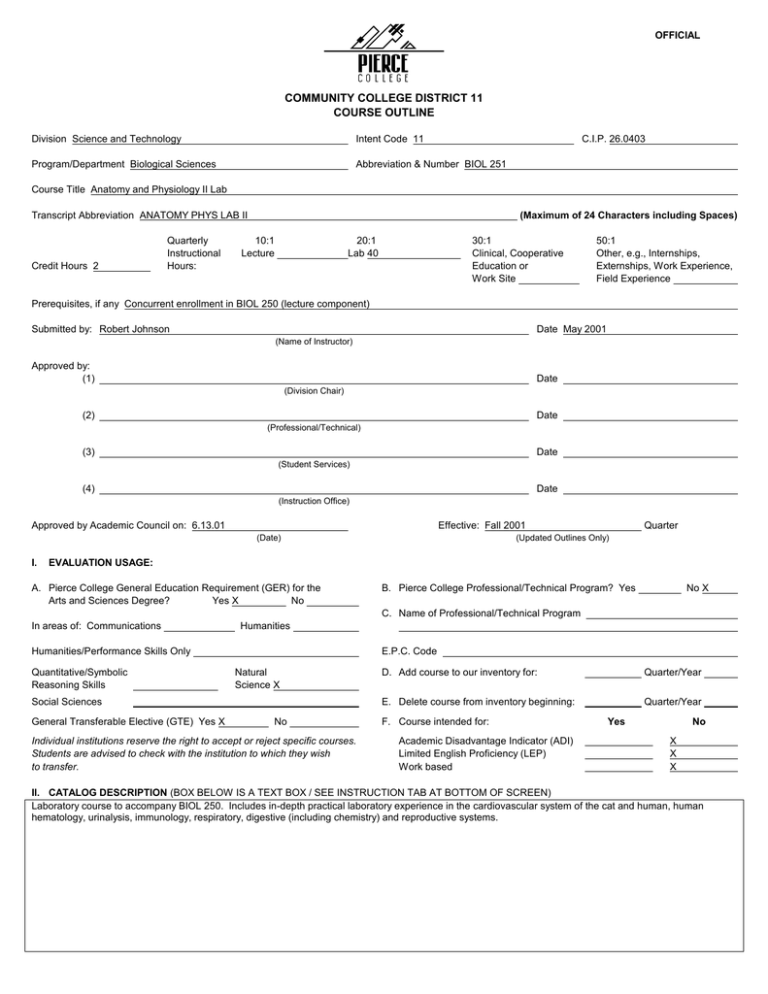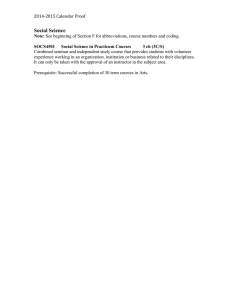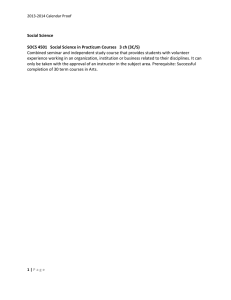COMMUNITY COLLEGE DISTRICT 11 COURSE OUTLINE
advertisement

OFFICIAL COMMUNITY COLLEGE DISTRICT 11 COURSE OUTLINE Division Science and Technology Intent Code 11 C.I.P. 26.0403 Program/Department Biological Sciences Abbreviation & Number BIOL 251 Course Title Anatomy and Physiology II Lab Transcript Abbreviation ANATOMY PHYS LAB II Credit Hours 2 Quarterly Instructional Hours: (Maximum of 24 Characters including Spaces) 10:1 Lecture 20:1 Lab 40 30:1 Clinical, Cooperative Education or Work Site 50:1 Other, e.g., Internships, Externships, Work Experience, Field Experience Prerequisites, if any Concurrent enrollment in BIOL 250 (lecture component) Submitted by: Robert Johnson Date May 2001 (Name of Instructor) Approved by: (1) Date (Division Chair) (2) Date (Professional/Technical) (3) Date (Student Services) (4) Date (Instruction Office) Approved by Academic Council on: 6.13.01 Effective: Fall 2001 (Date) I. Quarter (Updated Outlines Only) EVALUATION USAGE: A. Pierce College General Education Requirement (GER) for the Arts and Sciences Degree? Yes X No B. Pierce College Professional/Technical Program? Yes No X C. Name of Professional/Technical Program In areas of: Communications Humanities Humanities/Performance Skills Only Quantitative/Symbolic Reasoning Skills E.P.C. Code Natural Science X Social Sciences General Transferable Elective (GTE) Yes X No Individual institutions reserve the right to accept or reject specific courses. Students are advised to check with the institution to which they wish to transfer. D. Add course to our inventory for: Quarter/Year E. Delete course from inventory beginning: Quarter/Year F. Course intended for: Academic Disadvantage Indicator (ADI) Limited English Proficiency (LEP) Work based Yes No X X X II. CATALOG DESCRIPTION (BOX BELOW IS A TEXT BOX / SEE INSTRUCTION TAB AT BOTTOM OF SCREEN) Laboratory course to accompany BIOL 250. Includes in-depth practical laboratory experience in the cardiovascular system of the cat and human, human hematology, urinalysis, immunology, respiratory, digestive (including chemistry) and reproductive systems. COURSE OUTCOMES BIOL251 COURSE NUMBER: COURSE TITLE: COURSE CONTENT: A. Hematology (study of blood) B. Heart and vascular routes C. Lymphatic/immune system D. Respiratory system E. Digestive system and digestive chemistry F. Metabolism G. Urinary system H. Acid/base balance relationships I. Reproductive system J. Endocrine system STUDENT OUTCOMES Human Anatomy and Physiology II: Laboratory Core Abilities Indicate the desirable results that can be expected to occur from the course experience. These are usually expressed in measurable and observable terms. 1. Correlate qualitative and quantitative information about the constituents of blood via microscopic examination. (Written Report, Instructor Observation, Group Activity, Laboratory Practicum) 2. Generate a hematology slip following the performance of a hematocrit and a differential white blood cell count from a blood smear stained with Wright’s stain. (Written Report, Instructor Observation, Laboratory Report, Laboratory Practicum) 3. Recognize the ABO blood type and Rh factor from an agglutination test and describe the frequencies of blood types among the various ethnic populations applying genetic concepts. (Instructor Observation, Oral Presentation, Group Activity, Laboratory Report, Laboratory Practicum) 4. Identify superficial and deep structures of the heart, including the conduction system, on various heart models, diagrams, and by sheep heart dissection. (Instructor Observation, Oral Presentation, Group Activity, Laboratory Report, Laboratory Practicum) 5. Describe and demonstrate patterns of blood circulation throughout the human body, including systemic, pulmonary, cerebral, coronary, hepatic portal, and fetal circulations on models, diagrams and dissected cat specimens. (Instructor Observation, Oral Presentation, Group Activity, Laboratory Practicum) 6. Measure blood pressure and discuss its functional interrelationships with pulse pressure, mean arterial blood pressure, cardiac output, peripheral resistance and hemodynamics. (Instructor Observation, Oral Presentation, Group Activity, Laboratory Practicum) 7. Identify the gross and microscopic anatomy of the lymphatic system, including pattern of lymph circulation and both its encapsulated and non-encapsulated structures. (Instructor Observation, Oral Presentation, Group Activity, Laboratory Practicum) 8. Identify the gross and microscopic anatomy of the respiratory tract and related organs. (Instructor Observation, Oral Presentation, Group Activity, Laboratory Practicum) 9. Measure pulmonary air volumes and capacities using a spirometer. (Written Report, Instructor Observation, Oral Presentation, Group Activity, Laboratory Report, Laboratory Practicum) 10. Assess problems dealing with metabolic/respiratory acidosis and alkalosis. (Written Report, Instructor Observation, Group Activity, Laboratory Report, Laboratory Practicum) 11. Describe mechanisms of gas exchange in the lungs and tissues as well as gas transport in the blood. (Written Report, Instructor Observation, Group Activity, Laboratory Report, Laboratory Practicum) 12. Identify the gross and microscopic anatomy of the GI tract and the accessory organs of digestion, including the mesenteries. (Instructor Observation, Oral Presentation, Group Activity, Laboratory Practicum) 13. Perform and evaluate digestive chemistry experiments and discuss the catabolism and anabolism of carbohydrates, lipids, proteins, and nucleic acids. (Written Report, Oral Presentation, Group Activity, Laboratory Report, Laboratory Practicum) 14. Identify the gross and microscopic anatomy of the urinary tract, including detailed X X X X X X X X X X X X X X X X X X X X X X X X X X X X X X X X X X X X X X X X X X X X X X X X X histology of the nephron and its juxtaglomerular apparatus. (Instructor Observation, Oral Presentation, Group Activity, Laboratory Practicum) 15. Assess results following performance of a urinalysis, which includes gross examination, specific gravity, biochemical analysis, and microscopic examination. (Instructor Observation, Oral Presentation, Group Activity, Laboratory Report, Laboratory Practicum) 16. Interrelate concepts of buffer systems, their roles in acid/base balance, regulation of volume and chemical composition of body fluids, and the roles of the respiratory and urinary systems following measurement of pH of biological and nutritional fluids. (Instructor Observation, Oral Presentation, Group Activity, Laboratory Practicum) 17. Identify gross and microscopic anatomy of the male and female reproductive tracts and external genitalia, including an in depth examination of reproductive cell division (meiosis, gametogenesis, folliculogenesis) and describe the functions of these structures. (Instructor Observation, Oral Presentation, Group Activity, Laboratory Report, Laboratory Practicum) 18. Identify the gross and microscopic anatomy of the endocrine system, including the major endocrine organs, with emphasis on interrelating which target tissues are regulated by the secretions of these organs. (Instructor Observation, Oral Presentation, Group Activity, Laboratory Practicum) X X X X X X X X X X X X X X X X METHODS AND TOOLS FOR ASSESSMENT: A. Written Report: Description of activity or concept in an accurate, concise fashion using appropriate, accepted scientific writing format. B. Instructor Observation: Instructor visually assesses either informally or formally (with a checklist) whether the student has successfully achieved the desirable outcome. C. Oral Presentation: Presentation of subject concepts through verbal explanation from students either as individuals or as groups. D. Group Activity: Examination of subject concepts or questions through a formalized group activity requiring active participation of all group members. E. Laboratory Report: Presentation of laboratory experiment results in a brief written form including laboratory objectives and conclusion. F. Laboratory Practicum: Use of student demonstration of techniques and student knowledge of anatomical structures, physiological processes, scientific equipment, and laboratory materials as a means of assessment.


